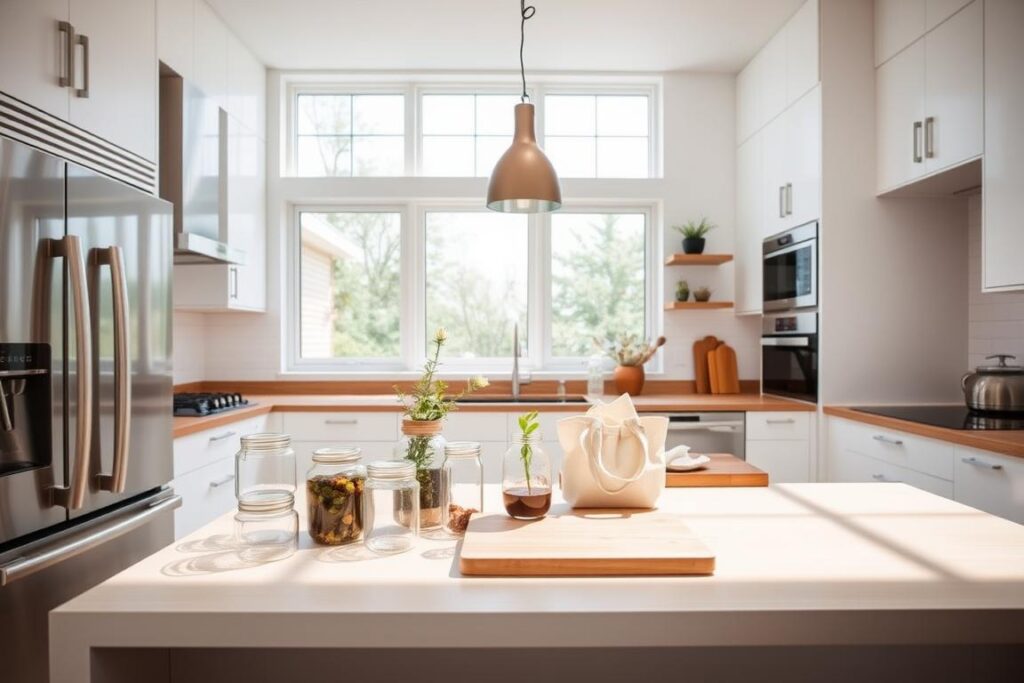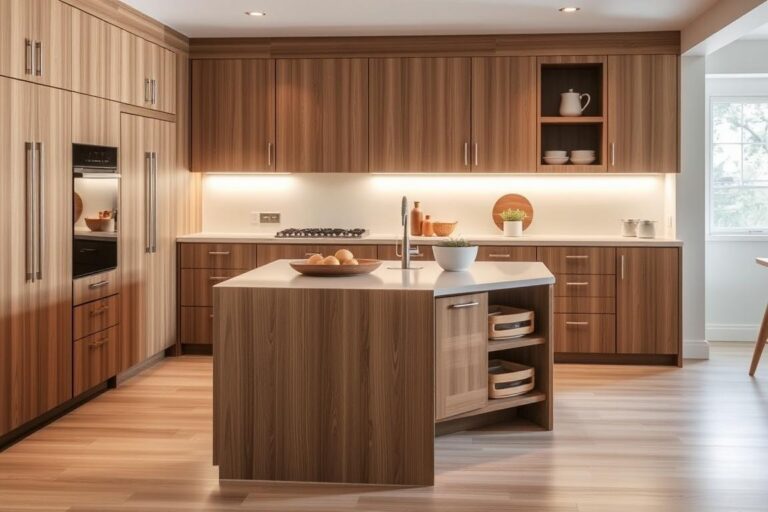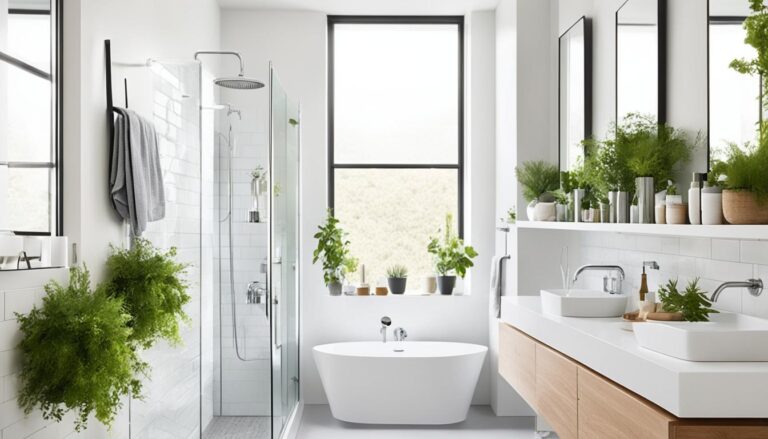We want to help you make a zero waste kitchen. This will not only cut down on waste but also help the planet. Food waste in the U.S. is huge, at 103 million tons. It’s time to act.
By using green kitchen ideas, you can make a big difference. We’ll show you a simple 5-step way to get to a zero waste kitchen.
Key Takeaways
- Zero waste kitchen design can greatly reduce waste and lessen your kitchen’s impact on the environment.
- Choosing reusable items and green kitchen ideas can cut down on single-use plastics.
- Bulk buying and composting food scraps can help waste not end up in landfills and improve soil.
- Switching to sustainable utensils and energy-saving appliances can reduce landfill waste and lower energy use.
- Supporting local farmers and eating vegan can lessen resource use and environmental impact.
By following these steps and using green kitchen practices, you’re on your way to a zero waste kitchen. This will help you and the planet. We’ll dive into each step, giving you the info to make smart kitchen design choices.
Understanding Zero Waste Kitchen Design Principles
Creating a more sustainable living space starts with a zero-waste kitchen. This design aims to cut down on waste and lessen kitchen activities’ environmental harm. By choosing a minimalist kitchen design, we can greatly lessen kitchen waste.
Green kitchen remodeling is key in zero-waste design. It uses eco-friendly materials and practices to lower waste and support sustainability. This includes recyclable materials, less energy use, and waste-free kitchen solutions like composting and recycling.
- Reducing waste and promoting sustainability
- Saving money on energy and water consumption
- Creating a healthier living space by reducing exposure to toxic chemicals and pollutants
By applying these principles, we make our kitchen more sustainable and eco-friendly. This benefits our health and the planet.
Assessing Your Current Kitchen Space
To make a zero-waste kitchen, we need to check our kitchen. We look at the layout, appliances, and how we handle waste. This helps us find ways to cut down on waste and make our kitchen greener.
Understanding where waste comes from is key. We can start by tracking our waste. This shows us what we can cut down on, like food waste, packaging, and paper.
Conducting a Waste Audit
A waste audit helps us see how much waste we make. By sorting our waste, we can find ways to make less. For example, composting food and using reusable containers helps a lot.
Identifying Major Waste Sources
Finding out where most waste comes from is important. In the kitchen, common waste includes:
- Food waste
- Packaging waste
- Paper products
By looking at our kitchen and making changes, we can make it better for our health and the planet. Every little bit helps, and cutting down on waste is a big step towards living greener.
| Waste Source | Waste Reduction Strategy |
|---|---|
| Food waste | Composting, meal planning |
| Packaging waste | Using reusable containers, buying in bulk |
| Paper products | Using reusable towels, switching to digital documents |
Planning for Sustainable Materials and Appliances
We think planning for green materials and appliances is key for a zero-waste kitchen. By picking eco-friendly stuff, you cut down on waste. Good choices include bamboo, stainless steel, and recycled glass.
For appliances, go for energy-saving ones like LED lights and Energy Star-rated stuff. These cut down energy use and carbon emissions. ENERGY STAR appliances use 10-50% less energy than regular ones. Also, using paints with low VOCs and reclaimed wood makes your kitchen greener.
- Choosing eco-friendly materials for cabinets and countertops
- Selecting energy-efficient appliances and lighting
- Using natural lighting and ventilation to reduce energy consumption
- Incorporating recycling and composting options into the kitchen design
Adding these green elements makes your kitchen zero-waste. It’s better for the planet and a healthier place to cook and hang out.
Incorporating Smart Storage Solutions
We think smart storage is key to a clean and green kitchen. Eco-friendly ideas like multi-functional furniture and new container solutions help. For example, using reusable containers and bags cuts down on plastic.
Some ways to make your kitchen waste-free include:
- Installing a kitchen island with built-in storage to save space and cut waste
- Using glass jars and stainless steel containers to lessen plastic use and help the planet
- Putting in a pull-out pantry and slide-out drawers for easy access to heavy items and for storing pots, pans, and bowls
These smart storage ideas make kitchens more efficient and green. They help us live better and protect our planet. Let’s keep finding ways to make kitchens more eco-friendly and waste-free.
Optimizing Food Storage Practices
As we design our zero waste kitchen, it’s key to focus on food storage. A few simple steps can cut down kitchen waste a lot. Using bulk bins and reusable bags is a great start. It cuts down on packaging waste and supports green living.
Utilizing Bulk Bins and Reusable Bags
Start by using bulk bins for dry goods like pasta, rice, and grains. It cuts down on packaging and helps us buy only what we need. Also, reusable bags for shopping cut down on single-use plastic bags.
Best Practices for Food Preservation
To cut down waste, follow good food preservation habits. Use airtight containers for leftovers, label and date stored food, and freeze near-expired food. These steps help reduce waste and make our kitchen more sustainable.
Optimizing food storage and reducing waste makes our kitchen greener. It’s good for the planet and saves us money. By following these steps, we can make a big difference in our zero waste kitchen journey.
Transitioning to a Paperless Kitchen
Exploring sustainable kitchen practices is key. Moving to a paperless kitchen is a big step. Digital meal planning tools help cut down on paper waste.
Using reusable food wraps like beeswax and silicone lids also helps. Green kitchen ideas suggest simple swaps. Ceramic-coated cookware and glass containers are good for health and the planet.
Benefits of a paperless kitchen include:
- Less paper waste
- Smaller environmental impact
- Save money on paper towels and napkins

Reusable products like cloth paper towels cut down on plastic. Simple changes lead to a greener lifestyle.
| Product | Benefits |
|---|---|
| Reusable food wrap alternatives | Reduce plastic waste, promote sustainability |
| Digital meal planning tools | Reduce paper waste, promote sustainable kitchen practices |
Embracing Composting and Recycling
We think composting and recycling are key to a green kitchen. They help cut down on waste. The United Nations says 931 million tonnes of food was wasted in 2019. This is 17% of all food meant for people.
Composting and recycling are good for the planet. A kitchen compost bin turns food scraps into soil. This helps the environment. Knowing how to recycle is also important. It helps cut down on waste.
- Reducing landfill contribution by approximately 25%
- Improving soil health by replenishing vital nutrients
- Supporting sustainable agricultural practices
Composting and recycling help our planet. We urge everyone to try these green practices. Let’s make a difference together.
Adopting Minimalism in Kitchen Essentials
Creating a sustainable kitchen starts with minimalism. A minimalist kitchen design cuts down on waste. It also encourages eco-friendly habits. Quality, sustainable items help us live healthier.
In green kitchen remodeling, think about the planet. Eco-friendly materials and fewer single-use items make a big difference. Here’s how:
- Keep only what you need in your kitchen.
- Use reusable items instead of disposable ones.
- Choose durable, green kitchen items.
Minimalism in the kitchen means less clutter and better for the planet. Every choice we make helps. Starting with our kitchen essentials is a smart move.
| Benefits of Minimalist Kitchen Essentials | Description |
|---|---|
| Reduced Waste | By cutting out single-use items and choosing green materials, we lessen waste. This supports eco-friendly living. |
| Increased Efficiency | A minimalist kitchen makes cooking and meal prep easier. It helps us make healthy, green meals. |
Enhancing Your Kitchen with Indoor Gardening
We think adding indoor gardening to your kitchen is a smart move. It makes your kitchen look and work better. Growing your own herbs cuts down on waste and supports green living, fitting our sustainable kitchen practices and eco-friendly kitchen ideas.
Benefits of Growing Your Own Herbs
Having your own herbs brings many perks. It means less waste and more fresh, healthy food. Indoor gardening also cleans the air and makes your kitchen feel better.
Tips for Indoor Gardening Success
Here are some tips to help your indoor garden thrive:
- Pick easy-to-care-for plants like basil or mint for your indoor garden.
- Use self-watering planters and LED grow lights to help your plants grow.
- Make sure your plants get enough light. Use natural light or artificial lights if needed.
Adding indoor gardening to your kitchen makes it special and eco-friendly. We suggest trying indoor gardening and growing your own herbs. It’s a great way to make your kitchen better for you and the planet.
| Plant Type | Maintenance Level | Lighting Requirements |
|---|---|---|
| Basil | Low | Medium |
| Mint | Low | Low |
Educating Household Members on Zero Waste
Creating a sustainable kitchen is key. We must teach our family about zero waste. Together, we can cut down on waste and live greener. 66% of consumers are more likely to buy unpacked items, showing a move towards green shopping.
Hosting Family Workshops
Family workshops are great for teaching zero waste. They help us understand why less waste is better. We learn eco-friendly tips and how to make our kitchen greener.
Providing Resources for Eco-Friendly Practices
It’s important to share eco-friendly tips. This includes sustainable materials and ways to cut down on food waste. Learning about zero waste helps us:
- Reduce waste and protect the environment
- Save money by using less energy and waste
- Stay healthier by avoiding harmful chemicals
Exploring Local Resources for Zero Waste
We think it’s key to find local resources for zero waste. This helps us cut down on waste and make our kitchens greener. In the US, we throw away about 4.5 pounds of trash each day. This adds up to 12% of the world’s waste.
To solve this, we can use eco-friendly kitchen habits. This means less waste and a cleaner planet.
Here are some ways to find local zero waste resources:
- Look for bulk stores with refillable containers and no packaging
- Join community efforts on composting, recycling, and waste reduction
- Shop at local farmers’ markets and businesses that care about the environment
By doing these things, we can make our communities greener. Let’s all work together towards a zero-waste kitchen. Let’s find local resources and support sustainable kitchen practices.
Celebrating Your Zero Waste Kitchen Journey
Starting your zero waste kitchen design journey is exciting. It’s important to celebrate your progress and share your story. This way, you can inspire others to reduce their environmental impact.
Sharing Your Story and Progress
Be proud of your eco-friendly kitchen steps. Share your experiences, challenges, and wins with friends and online groups. Show off your zero waste successes, like smart storage and composting.
Your story can motivate others to go green in their kitchens too.
Encouraging Others to Start Their Journey
Share the good things you’ve seen from going zero waste. It can cut down on carbon and save money on food. Your journey shows how small changes add up.
Encourage your friends to find local eco-friendly stores and composting programs. This can help them start their own green kitchen journey.
FAQ
What is the purpose of designing a sustainable zero-waste kitchen?
How can I conduct a waste audit to identify major waste sources in my kitchen?
What are some eco-friendly materials and energy-efficient appliances I should consider for my zero-waste kitchen?
How can I incorporate smart storage solutions to maintain a clutter-free and sustainable kitchen?
What are some best practices for optimizing food storage and reducing waste in the kitchen?
How can I transition to a paperless kitchen and reduce waste?
What are the benefits of embracing composting and recycling in the kitchen?
How can I adopt minimalism in my kitchen essentials to reduce waste?
What are the benefits of enhancing my kitchen with indoor gardening?
How can I educate my household members on zero-waste practices?
What local resources can I explore to support my zero-waste kitchen journey?
How can I celebrate and share my zero-waste kitchen journey?
Source Links
- https://sustainablereview.com/10-practical-steps-in-creating-a-perfect-zero-waste-kitchen/
- https://www.treehugger.com/tour-of-my-zero-waste-kitchen-5024951
- https://www.electroluxprofessional.com/zero-waste-kitchen-blog-post/
- https://treadingmyownpath.com/2017/09/14/zero-waste-privilege/
- https://www.homebiogas.com/blog/kitchen-waste-disposal/?srsltid=AfmBOoqkSRt1hZhlMVhADeoJ7DPEMnSdL85KNqNIq8QKuXMfcG7rhW96
- https://sicora.com/green-kitchen-remodeling-a-comprehensive-guide/
- https://woodbridgekb.com/eco-friendly-kitchen-remodeling-on-a-budget-in-2024/
- https://www.lorddecor.com/blog/eco-friendly-kitchen-products-for-sustainable-cooking-zero-waste
- https://sunnyfieldscabinetry.com/news/2024/07/designing-an-eco-friendly-kitchen-sustainable-materials-and-practices/
- https://www.bkckitchenandbath.com/planning-a-sustainable-kitchen-with-eco-friendly-materials/
- https://www.aalborkitchens.com.au/blog/transform-your-kitchen-into-an-eco-friendly-haven
- https://food52.com/blog/6505-designing-smart-kitchen-storage?srsltid=AfmBOorb_1s7goQldXhnEZ58N9BMURDoJgL2neNeNxWirBPrt3mq-FOQ
- https://hpgconsulting.com/commercial-kitchen/waste-not-want-not-strategies-for-reducing-food-waste-in-commercial-kitchens/
- https://theaicuisine.com/harnessing-ai-for-zero-waste-kitchens-revolutionizing-fine-dining-sustainability/
- https://www.greenify-me.com/2020/07/how-to-have-a-paperless-kitchen.html
- https://www.goingzerowaste.com/blog/reusable-paper-towels/
- https://superbee.me/how-to-be-a-zero-waste-kitchen/?srsltid=AfmBOop6whJEF5yTHk0ghr_RXge4tUT9OyTyWkPmjusTskZdoP3Y-1-b
- https://usahomeremodeling.com/kitchen-remodeling-contractor/zero-waste-kitchen-design-strategies-creating-a-sustainable-heart-of-the-home/
- https://www.vegandesign.org/blog/the-impact-of-composting-on-reducing-kitchen-waste
- https://theminimalistvegan.com/zero-waste-kitchen/
- https://www.raelambert.com/blog/minimalist-kitchen-essentials
- https://amazingfoodanddrink.com/shift-towards-minimalist-cooking/
- https://www.greencitytimes.com/sustainable-eco-friendly-kitchens/
- https://rhdesignstudio.com/revolutionizing-your-space-a-complete-guide-to-innovative-kitchen-design/
- https://designwell365.com/design/residential/this-zero-waste-kitchen-makes-sustainability-simple/
- https://www.linkedin.com/pulse/can-you-make-your-kitchen-zero-waste-electrolux-professional-group
- https://magazine.avocadogreenmattress.com/what-is-zero-waste-cooking/
- https://www.zerowaste.com/zero-waste-home-guide/
- https://www.marketman.com/blog/guide-to-zero-waste-restaurants
- https://zerowastestore.com/pages/zero-waste-lifestyle-2025?srsltid=AfmBOoqA0c6fqunEWmqYOGPfkkA5Qk44J3qJLnSRDmhmYlXwj3FUwS-P
- https://www.goingzerowaste.com/blog/2015-9-3-my-zero-waste-kitchen/
- https://la.flavrreport.com/how-to-design-a-zero-waste-kitchen/
- https://lowimpactlove.com/zero-waste-kitchen/




